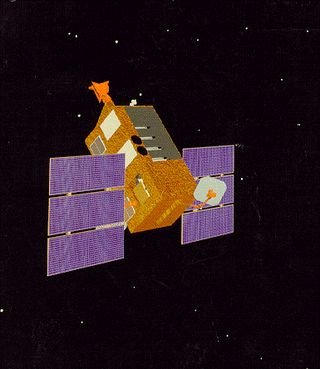Retired Satellite's Fall From Space Will Exceed NASA Safety Rules

The Rossi X-ray Timing Explorer, a NASA satellite retired from service Jan. 5, will present a 1-in-1,000 chance of harming someone when it makes an uncontrolled fall from Earth orbit some time after 2014, a level ten times riskier than NASA now requires for re-entering spacecraft, according to an agency spokesperson.
The forecast for the satellite's re-entry calls for a return between 2014 and 2023. Fluctuations in solar activity cause the atmosphere to expand and contract, making it difficult to accurately predict when uncontrolled satellites will re-enter.
The satellite, launched in December 1995, was designed before NASA issued standards for public safety from re-entering spacecraft. NASA satellites must now have a probability of striking a person of less than 1-in-10,000.
"This satellite was launched four months before the first NASA standard on orbital debris mitigation and re-entry risk management was issued," said Beth Dickey, a spokesperson at NASA Headquarters in Washington. "As such, it was not subject to the re-entry risk guideline, since it had already been built."
NASA's Upper Atmospheric Research Satellite, or UARS, re-entered the atmosphere in September, spreading debris over the unpopulated Pacific Ocean. It carried a risk of 1-in-3,200 of a human casualty, but the event caused no injuries or damage.
"Later, NASA did evaluate the re-entry risk for RXTE and found it to be on the order of 1-in-1,000, or about ten times the maximum desired risk level," Dickey told Spaceflight Now.
Satellites with the risk of RXTE typically re-enter ever few years. No one has ever been reported hurt by falling satellite debris.
Get the Space.com Newsletter
Breaking space news, the latest updates on rocket launches, skywatching events and more!
The RXTE spacecraft does not carry propellant, so leftover rocket fuel and tanks are not a concern, according to NASA officials.
Germany's ROSAT X-ray observatory uncontrollably crashed back into Earth's atmosphere in October with a 1-in-2,000 risk of harming a person. There were no reports of casualties from ROSAT's re-entry.
RXTE is circling 294 miles above Earth in an orbit that passes over regions between 23 degrees north and south latitude. When the 7,000-pound satellite falls from orbit, it will only threaten areas lying under its equatorial flight path.
During its 16-year mission, RXTE gave researchers glimpses of the inner workings of black holes and neutron stars.
Copyright 2009 SpaceflightNow.com, all rights reserved.
Join our Space Forums to keep talking space on the latest missions, night sky and more! And if you have a news tip, correction or comment, let us know at: community@space.com.
Stephen Clark is the Editor of Spaceflight Now, a web-based publication dedicated to covering rocket launches, human spaceflight and exploration. He joined the Spaceflight Now team in 2009 and previously wrote as a senior reporter with the Daily Texan. You can follow Stephen's latest project at SpaceflightNow.com and on Twitter.
Most Popular



